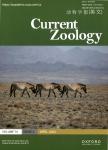As clear as mud: Turbidity induces behavioral changes in the African cichlid Pseudocrenilabrus multicolor
As clear as mud: Turbidity induces behavioral changes in the African cichlid Pseudocrenilabrus multicolor作者机构:Department of Biology McGill University 1205 Dr. Penfield Ave Montreal QC Canada H3A 1B1 Wildlife Conservation Society 2300 Southern Boulevard Bronx NY 10460 USA
出 版 物:《Current Zoology》 (动物学报(英文版))
年 卷 期:2012年第58卷第1期
页 面:146-157页
核心收录:
学科分类:0710[理学-生物学] 090801[农学-水产养殖] 07[理学] 0908[农学-水产] 0905[农学-畜牧学] 09[农学] 0906[农学-兽医学] 071002[理学-动物学]
基 金:National Science and Engineering Research Council of Canada (NSERC) American Cichlid Association Canada Research Chair funds
主 题:攻击行为 浊度水 多色 非洲 水生生物多样性 泥浆 社会行为 鲷
摘 要:Aquatic biodiversity is being lost at an unprecedented rate. One factor driving this loss is increased turbidity, an environmental stressor that can impose behavioral, morphological, and/or physiological costs on fishes. Here we describe the behavioral response of a widespread African cichlid,Pseudocrenilabrus multicolor victoriae, to turbidity. We used a split-brood rearing design to test if F1 offspring reared in turbid water, originating from river (turbid) and swamp (clear) populations, behave differently than full-sibs reared in clear water. We examined two facets of behavior: (1) behaviors of fish in full sib groups, including activity level and social dynamics collected during the rearing period; and (2) male aggressive behavior directed at potential male competitors after fish had reached maturity; this was done in an experimental set-up independent of the rearing aquaria. Regardless of population of origin, fish reared in turbid water were marginally less active and performed fewer social behaviors than those reared in clear water. On the other hand, when tested against a competitor in turbid water, males performed more aggressive behaviors, regardless of population of origin or rearing environment. Our results suggest a plastic behavioral response to turbidity that may allowP. multicolorto persist over a range of turbidity levels in nature by decreasing activity and general social behaviors and intensifying reproductive behaviors to ensure reproductive success.



